The most common plant diseases that occur on indoor flowers are described here. Attention: any plants, if agricultural practices are violated (flooding, hypothermia, overfeeding with fertilizers) or when planted in undisinfected soil, may show signs of several diseases. In the surrounding world there are not one or two types of microorganisms, but millions. We can guess the disease by single characteristic spots. There are specific diseases that cannot be confused with anything: gray rot (long threads of gray mold), powdery mildew (leaves as if covered with white dust), leaf dropsy in succulents (green pimples, the plant is not depressed), ring patterns from viruses and some other.
Lice are common pests of houseplants. The most famous is citrus lint, which has a very wide range of pet foods. It may also happen that she also attacks Kalanchoe. Lice are small insects with a flat, oval and soft body. Your body is divided into segments and covered with white, waxy scales. They feed on shoots and the lower part of Kalanchoe. Lice cause plant weakness, yellowing of leaves, stagnant and plugged shoots. As they feed, they contaminate the leaves with a white wooly or mealy coating that looks like cotton.
But very often plants exhibit several diseases at the same time, for example, in orchids, tracheomycosis (fusarium) and at the same time septoria or phyllosticosis. Root rot and Alternaria blight. The good news is that the ones offered to us in the store are usually effective against many diseases. But do not forget that drugs of hazard classes 3 and 4 are allowed for private households (i.e., for the home).
Like leaf and plant lice, lice excrete newborns that reproduce for fungi. Controlling lice on Kalanchoe is not difficult. They can be mechanically removed from the leaves using a fire-dyed brush. They can also be removed with a toothbrush. Then wipe the Kalanchoe leaves and shoots with cotton, water and gray soap. Another way to get rid of lice from Kalanchoe leaves is to use a rapeseed oil spray. This preparation can be quickly prepared in your own kitchen. 5 ml of rapeseed oil is diluted in 250 ml of water.
Alternaria and dry spotting
The causative agent is fungi of the genus Alternaria. The fungus mainly affects leaves, sometimes stems and tubers.
Symptoms: Dry ones appear first. brown spots, first of all on the lower and then on the upper leaves. Typically, concentric circles are visible on the spots. As the spot enlarges, it gradually turns black, and gray conidia become visible on it.
You can add two drops of liquid gray soap to this solution so that the preparation sticks better to the surface of the sheet and does not drain so quickly. Spraying is carried out 3 times, 1 time every 1-2 days. Remember! After spraying, place the pot of Kalanchoe in a ventilated place so that the leaves can dry quickly without any water droplets remaining on them.
Leaves are more than decorative accessories to the gorgeous pink color. Foliage faces the vital task of keeping its metabolism moving through photosynthesis. For this purpose, air rose petals are taken carbon dioxide and capture sunlight, so that in combination with the glucose content of water as an energy supplier for.
Frequent temperature changes and changes in humidity contribute to the spread of the disease, i.e. alternating dry and wet periods. But the optimal conditions for the development of the fungus are at temperatures above about 25-30°C and humidity up to 90%.
Prevention
Avoid crowding the plants; cut out unnecessary branches and leaves during planting. Ventilate the room or greenhouse; if the flowers are on the balcony, make sure there is good ventilation and mold is not growing on the walls - this is an indicator of microclimate disturbances.
If, however, yellow leaves and brown spots develop, this finely balanced process is released from the joints and the overall growth for the rose plant increases. Read here what really helps now. Cause: Wrong mold. If summer comes with cool, wet weather, roses are at risk of fungal infestation. Symptoms show upper dark purple spots on the leaves that turn red-brown. Additionally, the entire leaf turns yellow and dies. At the same time, a grey-white, scaly spore lining similar to powdery mildew develops.
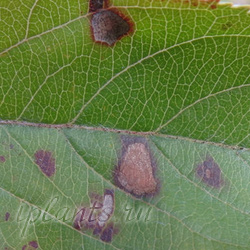

Control measures
Fungicides used to combat Alternaria blight:
- abiga peak 50 g per 10 liters of water
- acrobat MC 20 g per 5 liters of water
- oxychome 20 g per 10 liters of water
- home 40 g per 10 liters of water
- Vitaros 2 ml per 1 liter of water
Anthracnose
![]()

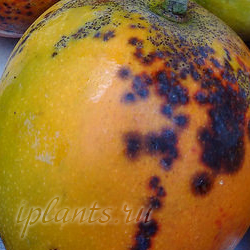
However, a higher potential risk is associated with powdery mildew because the pathogens penetrate deeply into leaf and shoot tissue, making control difficult. This helps: cut out infected foliage, administer fungicide, and strengthen neighboring plants.
In the case of mold on roses, you are faced with the worst leaf fungus that can visit an ornamental garden. When pathogens attack, biological control agents are lost. Therefore, treat the first symptoms consistently. Infected foliage is generously cut out and destroyed.
The causative agent is fungi of the genera Colletotrichum, Gloeosporium, Kabatiella. Palm trees, ficus, anthurium, etc. are more often susceptible.
Symptoms: The disease affects the leaves, stems, petioles and fruits of plants. Spots on different plants, and depending on the pathogen, look different.
- Kabatiella zeae - causes the formation of small round or irregularly shaped spots, 2-5 mm in diameter with a clear outline. It looks like a yellow spot with a brown or black dot inside. If the spot is larger, instead of a black dot, a dark rim is formed, and inside it is a grayish ring.
- Colletotrichum orbiculare - causes the formation of usually reddish-brown spots, often with a slight yellow border, from 2 to 12 mm. On some plants the spots are pale green. Round or elongated in shape. In the affected areas, the spots merge, dry out, become like parchment, crack, and holes form.
- Colletotrichum trichellum - large yellowish-brown or gray-brown spots on leaves and stems with dark sporulation pads. If you look closely, you will notice that on the spots on the upper side of the leaf, the surface is not smooth, but covered with fluffy hairs of spores, however, the spores are noticeable even when the plant is severely damaged. The spots on the fruit are gray-brown with a dark center, depressed.
Anthracnose develops quickly in greenhouse conditions, i.e. at high air humidity (about 90-100%) and elevated temperature 22-27 °. And also with frequent (several times a day) spraying of plants. The fungus is frost-resistant - it is preserved in plant debris, in seeds and spreads with water when watering.
Roses develop natural defenses against pathogens and pests when cared for with nitrogen-rich fertilization. In addition, the area should be sunny and air washed so that the moisture dries quickly. A sufficiently large planting distance prevents flowers from touching to prevent contamination. Reason: The star is black.
Insidious pathogen yellow leaves and brown spots in roses have been attacking plants since the end of May, without visible external symptoms. Old, weakened foliage near the ground is infected internally. If round brown spots grow on the leaves, the disease is already very advanced. Subsequently, the leaves become yellow and fall off. Since the rose is now completely weakened, the young foliage and shoots are not free from fungal spores.
Prevention
Removing leaves with suspicious spots, disinfecting the soil, treating seeds. Suspicious plants purchased in a store should be quarantined. If there are signs of disease, it is necessary to stop spraying the plants.
Control measures
Spraying is usually enough, three treatments using fungicides:
This helps: A combined package of control and prevention measures. When the first brown spots appear, all infected leaves should be pruned and destroyed. Federal Office for Consumer Protection and Safety food products publishes detailed review all approved plant protection products. Since sternum deficiency infection is limited to older leaves close to the ground, the next package is to control and prevent disease in the surrounding area.
Cause: Spider mites. Among the first suspects - pink roses in closed places such as balcony, yellow leaves and brown spots. Tiny pests prefer dry, warm myclimus to reproduce. The extreme suction action begins at the bottom of the leaf and causes yellow and brown color in the first phase.
- oxychome 15-20 g per 10 liters of water
- : 100 g per 10 liters of water
- colloidal sulfur: 50-100 g per 10 liters of water
- strobi fungicide, in a system with other fungicides, 4 g per 10 l of water
- abiga-pik: 50 g suspension per 10 liters of water
Ascochyta blight
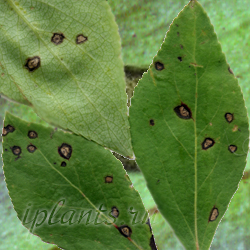
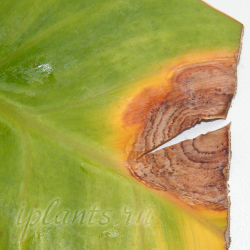
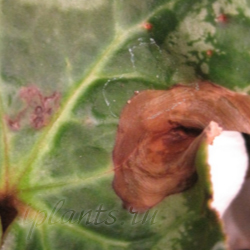
As a result, the leaves turn yellow and fall to the ground. As a rule, infected rose petals are covered with delicate ribbons. This helps: change location, potassium soap solution, bioinceticide, beneficial. In the first phase of the battle, spider mites will make their environment as unpleasant as possible. Since the occurrence of these pests is always also a location issue, we recommend leaving the protection of the canopy. For a rose in a bucket, this adjustment can be solved by simply moving it. For roses in the garden, it is worth the effort of replanting, as the pests will reappear annually on sites that address them.
The causative agent is fungi of the genus Ascochyta. The most severe damage is caused by ascochyta blight of chrysanthemums, which most often affects plants of the Asteraceae family.
Symptoms: at the initial stage, small, only 1-2 mm reddish or brown spots appear on the leaves, sometimes brown, reddish with a yellowish or brown rim, of various shapes. The spots increase in size and acquire a dark brown necrotic hue with a yellowish chlorotic border along the edge. Small black spores of the fungus can only be seen under magnification with a magnifying glass. If the growth of a fungus on a stem rings it, the stem easily breaks.
At these stages you continue.
- Cut off infested leaves and dispose of them in household waste.
- Spray the rose every 2-3 days with a mixture of 1 liter of water and 15 ml of potassium soap.
Once they have done their job, they set off again to seek new pastures. Baking flash using neem oil makes a valuable contribution to preventing the spread of spider mites and other pests that cause yellow leaves and brown spots in roses. If young rose leaves turn yellow interspersed with green leaves in a herringbone pattern, the ornamental plant is suffering from iron deficiency. As a natural trace element, iron is involved in photosynthesis and contributes to the color of rich foliage.
Sometimes the disease begins with signs of overdrying of the plant - the tips of the leaves begin to dry out, and a dark brown stripe forms at the border with healthy tissue. The pathogen is very resistant to deep temperature changes, i.e. It tolerates both severe drought and soil frost. Preserved on plant debris and seeds. The disease spreads with wind, undisinfected soil, and drops of water.
In a normal garden, the iron is accessible enough to be grasped by the roots of the roses. If young rose petals turn yellow, followed by older foliage, immediate action will be required. Although there is a sufficient supply of the microelement in the soil, it is determined by an excess of lime. If the result is significantly higher than the ideal value of 5.5 to 6.5, the water is too chalky. Fill immediately with soft rainwater or at least alternately with tap water.
If you have pre-fertilized lime, set this measure. For environmentally-minded gardeners, a mixture of nettle and seaweed extract is recommended. So in the long term there are no yellow leaves due to iron deficiency, the soil is optimized with bog litter or peat. A mulched layer of bonewood and nettle or bark humus keeps the acid in balance and draws iron from the deeper layers of the soil.
Prevention and treatment, as with .
Dropsy of leaves (edema)
![]()
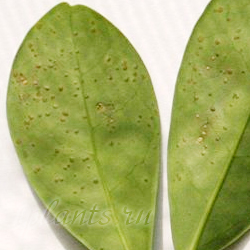
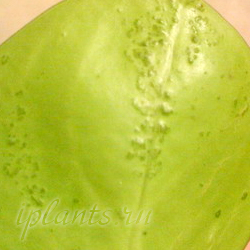
A disease not caused by a fungus or bacteria, but resulting from waterlogging of the soil, often with insufficient lighting. It usually appears in succulents, typically in peperomia, crassula, Kalanchoe, possibly on pelargonium, schefflera.
Yellow leaves and brown spots are not to be taken lightly with roses. When these harmful patterns develop, the royal bloom is threatened. The horticulturalist must determine the cause and take appropriate countermeasures. The most common triggers presented here can be corrected early on through natural means, modified care, or changes in location. Where biological control fails, a wide range of effective retail products are ready to take the rose.
Symptoms: the plant, most often, barely noticeable pimples appear on the underside of the leaf, they seem watery, but in fact they are dense, sometimes like cork growths, some look like warts, the color of the leaf can be preserved, i.e. the spots are green and may acquire a gray necrotic color. This is caused by the fact that some of the roots die off (from drying out, waterlogging, hypothermia), and the nutrition through the conducting vessels that were supplied by these roots is disrupted. Since the waterlogging was not severe, the soil had time to dry out, the rotting did not spread further, but the stains remained. The affected leaves will not recover, but if the plant is given good conditions, then the new leaves will be healthy.
In fact, cicadas are better known from southern countries. However, what is less known is that there are about 1000 insects in this group various types There are tiny specimens about two millimeters long. There are also different species of these dwarf cicadas, with rosemary mainly producing the black spotted cicada, sulphur leaf cicada and Ligurian leaf cicada. Small, elongated and winged animals can also be seen in good light.
Yellow or yellow-white spots on the leaves are puncture sites. Fortunately, such cicadas cannot be harmful to the plant, so this is primarily an optical problem. However, you should take appropriate action as soon as possible as sucking the leaves of the sap weakens the plant in the long run. In addition, the animals are very mobile and can spread quickly. If you want to use yours, it is better to leave your fingers to chemical plant protection products. Instead, you can fight animals biologically.
The difference between dropsy (edema) and other diseases, root rot, is that the plant is not depressed, it grows noticeably, and the spots themselves are small in patches, affecting 1-3 leaves on the bush. Leaves with dropsy do not turn yellow, dry out or fall off!
Treatment and prevention: Adjust watering, do not overwater, loosen the soil after heavy watering and when compacting the soil in the pot. Make up the soil with a high proportion of draining, loosening particles - at least 1/5 or 1/4 of the volume of the pot.
Sprinkle a diluted vinegar solution on the plants to kill any remaining eggs.
- As a first measure, victims.
- Carefully remove the old substrate and shake the plant thoroughly.
- Rinse rosemary vigorously in the shower.
- Place in fresh substrate.
- Alternatively, move them to a new location.
Downy mildew (Peronosporosis)

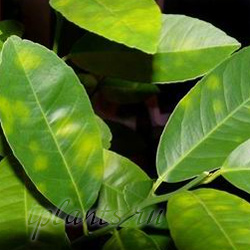
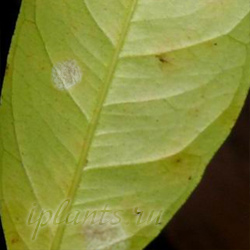
Pathogens are fungi of the genera Peronospora, Plasmopara, Pseudoperonospora, Mildew. The disease can affect any indoor plants, but the disease is quite rare.
The sooner you react, the sooner you will get rid of them. Prevention, control measures: adequate location and care conditions Control: natural herbal remedies, chemical plant protection products, cereals. The most common is iron deficiency in rhododendron. If the plant has not thickened for a long time, a special rhododendron may help. In addition to iron, they contain other nutrients, which are adapted to rhododendron. This is a small, versatile weapon, if it weren't just for the lack of iron.
Symptoms: yellow, then brown spots of irregular shape form on the upper side of the leaves; with downy rose of cucumbers, the spots are angular (specific to the structure of the leaf). Gradually, necrosis occurs in these places, and the spots become brown. On the underside of the leaves, at the beginning of the disease there is a light gray coating from the conidial sporulation of the pathogen that emerged on the surface of the leaf through the stomata, then this coating gradually turns black. Diseased leaves turn yellow, become wrinkled or corrugated, wither and dry out. With a severe degree of damage, the pathogen can penetrate the vascular system, which is noticeable on the cut in the form of darkened vessels (mycelium and spores).
The disease predominates on heavy acidic soils. The spread is aggravated by high humidity and poor ventilation. The source of infection is undisinfected soil and seeds.
Prevention
Maintaining low humidity, regular ventilation, thinning and cleaning of bushes. Changing the soil and its disinfection. If signs of the disease have already been detected, avoid spraying and when watering, avoid getting water on the leaves.
Preparing seeds for sowing:
- immersing them in hot water at 50°C for 20 minutes, followed by rapid cooling in cold water within 2-3 minutes
- soaking in a seed protectant, for example, Maxim
Control measures
Removing diseased leaves and severely affected branches. You can use preparations containing copper: oxychome, cuproxate, 1% solution, ordan. These fungicides are more accessible (cheap and effective) for treating garden and vegetable plants. You can get more modern drugs: quadris, bravo - but they are not sold in small packaging, they are intended only for Agriculture(in cans and bottles), gardeners usually purchase them in collective purchases.
Fungicides available for the simple grower are:
- topaz 4 ml per 10 liters of water
- abiga-pik 50 g suspension per 10 liters of water
- oxychome 15-20 g per 10 liters of water, three times
Start treatment at the first signs of the disease and repeat every 7-10 days, especially carefully treating the underside of the leaves. At least 3-4 treatments are necessary.
Preparations: pureflower, skor, rayok are ineffective against downy mildew.
Powdery mildew

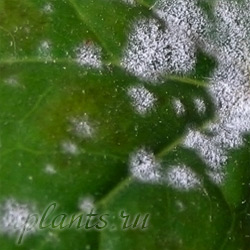
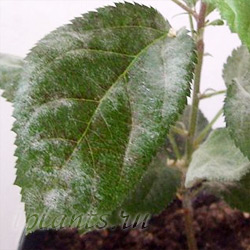
A common plant disease caused by fungi of the species Podosphaera fuliginea, Erysiphe cichoracearum and Oidium - powdery mildew on Oidium grapes.
Symptoms: at the beginning of the disease, small powdery spots appear on flowers and leaves. They are easily erased, but then appear again and increase in size, becoming a rich gray color. Gradually the mycelium thickens and becomes almost brown. Powdery coating can be on both sides of the leaf. The leaves gradually dry out, buds and flowers fall off, and plant growth stops. Most favorable conditions for the development of the disease - high humidity - about 60-80% and warm air within 15-26°C.
Of the domestic plants, powdery mildew most often affects: laurel, Saintpaulia, gloxinia, roses, gerberas, Kalanchoe, etc.
Prevention
To prevent powdery mildew in indoor plants and flowers, you can pollinate with sulfur 3-4 times during the summer. Overfeeding plants with nitrogenous fertilizers, especially during budding, increases the risk of powdery mildew. On the contrary, fertilizing with phosphorus and potassium fertilizers increases resistance to the powdery mildew pathogen. You should also ventilate the room more often, avoiding cold drafts. Pay attention to the bushes and trees that grow under your windows; if they show signs of the disease, you always need to be on alert - fungal spores are easily carried by the wind.
In addition to treatment with sulfur, preventive spraying with whey (reverse) can be carried out. Regular whole milk is also suitable, but whey is preferable (less traces on the leaves), you need to dilute it with water in a ratio of 1:3 and spray the plants. For prevention, repeat after 2 weeks.
Fighting powdery mildew at home
If powdery mildew has fallen on indoor flowers, and violets (Saintpaulias), potted gerberas, and indoor roses are especially susceptible, then you can use the same means as for garden plants, except for highly toxic ones (Bayleton), but preference should be given to fungicides such as topaz , speed
You can use the drugs Chistotsvet, Skor, Rayok - they are all available in small packaging, contain difenoconazole, dilute 2 ml per 5 liters of water. For fruit trees, vegetables and berries, dilute 2 g per 10 liters of water, maximum 4 treatments: the first - on a green cone, the rest - after 12-14 days, stop treatments 20 days before harvest.
It is quite safe to spray against powdery mildew at home with a solution of soda ash and copper sulfate: dilute 10 g of soda ash and 2 g of soap (laundry, tar) in 1 liter of water, and separately dissolve 2 g of copper sulfate in a glass of water. Pour the copper solution into the soda solution, add water to a liquid volume of 2 liters and spray the plants.
If you heard from someone a recipe for fighting powdery mildew with antibiotics, do not try to repeat it; penicillins, tetracyclines and other antibiotics do not act on fungal infections, in extreme cases, will help against bacteriosis, but no more.
You can use drugs such as Topaz, Vectra, Hom, Oxychom, Bordeaux mixture (1%). How to get rid of powdery mildew on gooseberries, currants, roses and other garden crops - read more:.
Spraying with iodine solution helps as a prevention and treatment: 1 ml alcohol pharmacy tincture Dilute iodine in 1 liter of water. Roses can be increased in concentration - dilute 1 ml per 400 ml of water.
Septoria
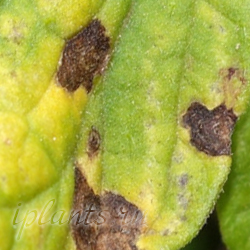
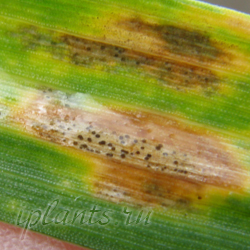
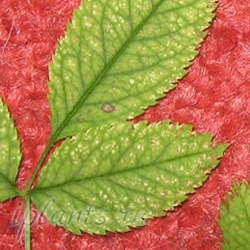
The causative agent is fungi of the genus Septoria.
Symptoms: dark brown or dark gray spots with a yellowish border (on anthurium) or, as on azaleas, small reddish or reddish-yellow spots that gradually increase in size. Then black spots appear in the center on the spots - the fruiting organs of the fungus, which can even overwinter on the leaves at sub-zero temperatures and the disease will begin to spread in the spring. Some forms of septoria have different manifestations (depending on the type of plant):
- The causative agent is Septoria albopunctata - looks like small 2-5 mm reddish-purple or brown spots with a gray center. As the disease progresses, the spots increase in size, and in the center of some of them you can see small dark brown or black spores of the fungus. Over time, the spots merge, turn brown, and the leaf dries out. Ideal conditions for the development of the disease - high humidity and temperature within 28-31°.
- The causative agent Septoria populi, the so-called white spot, first causes the formation of small whitish or gray spots with a brown rim around the edge, round or oval.
Prevention
Removing leaves with suspicious spots, disinfecting the soil, treating seeds. If there are signs of disease, it is necessary to stop spraying the leaves and improve air circulation (ventilation).
Treatment of septoria
When the stains have already appeared and are spreading further, it is necessary to spray using chemicals: among them, a 1% solution (100 g of copper sulfate + 100 g of lime per 10 liters of water, diluted strictly according to the instructions), a solution of copper oxychloride (homogeneous , oxychome), copper sulfate (100 g per 10 liters of water). And:
- colloidal sulfur 50-100 g per 10 liters of water
- strobe in a system with other fungicides, 4 g per 10 l of water
- abiga-pik 40-50 g per 10 liters of water
- fungicides: pureflower, speed, rayok, discor, keeper - any dilute 4 ml per 5 liters of water
- Vitaros 2 ml per 1 liter of water
Repeat spraying after 7-10 days.
Gray rot

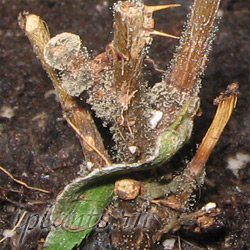

The causative agent is fungi of the genus Botrytis Botrytis.
Symptoms: most often, the affected areas appear on the stems in the form of a fluffy grayish-olive coating. With further development, the disease spreads to leaves, flower ovaries and fruits.
Over time, the lesion takes on the appearance of dry rot with concentric spots. After a few days, the spot grows and rings the stem. During the first week, there is no sporulation of the fungus on the spot; it turns pale in the center to a straw color, and blurred ring-shaped stripes become visible. Gray rot looks like gray loose cotton wool or mold. Tissue necrosis develops inside the stem, while the vessels die and the movement of water stops. The shoot above this zone withers.
Prevention
Preventive measures include disinfection of the soil during replanting (warming in the oven or microwave), regular ventilation of rooms, removal of dying leaves and thinning of seedlings, good lighting. Avoid waterlogging the soil, especially if it is kept cool, if the flowers are on the balcony in early spring or late summer - autumn. When transplanting, you can add trichodermin, barrier, barrier or phytosporin preparations to the soil (spill the soil).
Control measures
At the first sign of disease, remove diseased leaves and inflorescences. Sprinkle the affected area with charcoal powder, chalk or wood ash. You can make a paste from the trichodermin preparation (moisten a small amount of powder with water) and also coat the affected areas. Spraying with topsin-M solution (0.1%) or phytosporin solution (diluted to tea color). For severe damage, spray:
- (0,2%)
- copper-soap solution: 0.2% copper sulfate and 2% laundry soap
- fungicides: puretsvet, skor, rayok - any, dilute 4 ml per 5 liters of water
Repeated treatments are carried out after 7-10 days.
Sooty fungus
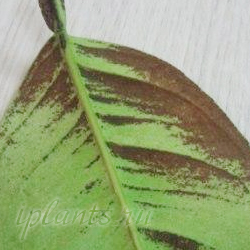
Appears in the form of a dry sooty film on aucubes, buxuses, and laurels. Caused by the fungus Capnopodium, which settles on the secretions of aphids, whiteflies, and mealybugs. The plaque itself is not dangerous for the plant, but it clogs the stomata on the leaves, thereby disrupting the respiration process. The plant slows down and weakens.
Control measures: timely spraying against pests that produce sweet secretions (aphids, scale insects, thrips). After curing the disease, wipe the affected plants with a sponge soaked in soapy water, rinse with warm, clean water, and treat with phytosporin: take the liquid or paste and dilute it in a glass of water until the color of weak tea. Spray the leaves.
Sometimes sooty fungus settles on the surface of leaves affected by other fungi; carefully examine the nature of the spots and quarantine the plant.
Leaf rust
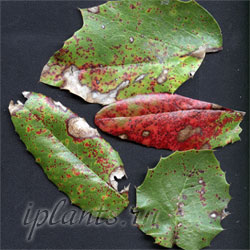


The causative agent is rust fungi, for example, of the genus Phragmidium or Puccinia.
Symptoms: expressed in the appearance of orange-brown tubercles, sometimes yellow or red round spots, on the upper surface of the leaf. On the reverse side of the leaf, pustules are clearly visible - pads (like warts) of oval or round shape. Gradually, the spots develop into stripes, the leaves turn yellow and fall off.
Prevention
The disease is provoked by uneven watering and high air humidity, but even with good care, infection is possible at home through cut garden flowers or with new potted plants purchased at the store, for example, gerberas. The infection can also come from garden soil, because rust often affects apple or pear trees.
Control measures
Remove affected leaves and branches. Apply fungicide spray:
- abiga-pik 50 g per 10 liters of water
- Bayleton 1 g per 1 liter of water
- Vectra 2-3 ml per 10 liters of water
- 10 g per 1 liter of water
- oxychome 15-20 g per 10 liters of water
- ordan 20 g per 5 liters of water
- strobes
- 4 ml per 10 liters of water
- home 40 g per 10 liters of water
Repeat the treatment 2-3 times after 10 days. Biological products do not help against rust: phytosporin, bactofit, etc.
Phyllosticosis (brown spot)
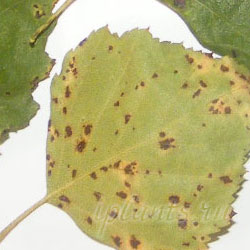
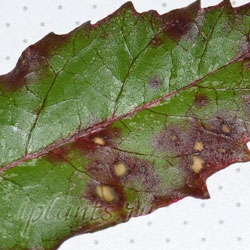
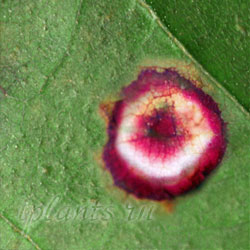
The causative agent is fungi of the genus Phyllosticta. Among domestic flowers, hibiscus, roses, orchids, etc. are susceptible to the disease.
Symptoms: Small, dark reddish or dark purple dots initially appear on affected plants. They enlarge and turn into brown spots with a purple, almost black border around the edge. The middle of the spot becomes thinner, dries out, and in plants with non-leathery leaves falls out and holes form. When examined through a magnifying glass, black round spores can be seen on the brown areas of the spot. The disease spreads with wind, undisinfected soil, and drops of water.
Phyllosticosis of orchids manifests itself in small spots about 2 mm in diameter, dark brown in color, slightly depressed, no holes are formed, the disease is often called “black spotting”, since the leaf is dotted with small spots like a rash - the spots do not merge into large ones, they remain scattered, but the leaf turns yellow, and then fungal spores become noticeable. The disease spreads quite quickly, since orchids are often in an atmosphere of high air humidity.
Prevention
Compliance with the rules of care and hygiene - timely watering when necessary, but not more often, pour water only at the root, water should not get on the root collar or in the axils of the leaves. Use only warm water for irrigation, without chlorine and salts (iron, calcium). Make sure plants have enough light; weakened, chlorotic leaves are more susceptible to infection. Ventilate the house or rooms, avoiding drafts. Ventilation should be very good - an indicator of proper ventilation is the absence of mold in the bathroom, around the perimeter of the window frame, in the corners of the rooms. Observe the temperature regime, take into account the species requirements of orchids and other plants - deviation from the norm and usual care weakens the immune system.
Treatment of phyllosticosis
- Vectra fungicide - dilute 2-3 ml of the drug per 10 liters of water
- abiga-pik - 50 g per 5 liters of water
- strobe - 4 g per 10 liters of water
- oxychome 20 g per 10 liters of water
- fungicides: pure flower, speed, rayok, discor, keeper - any dilute 1 ml per 1 liter of water
- Vitaros 2 ml per 1 liter of water
Spraying at the first signs of disease or preventive, then subsequent ones at intervals of 7-10 days. In some plants, you can safely remove the affected leaves (for example, in hibiscus); in orchids, do not rush to cut out the affected areas to healthy tissue, this can weaken the plants even more. You can trim the leaf only when it has already turned very yellow. For the rest, treat by spraying.
Root rot
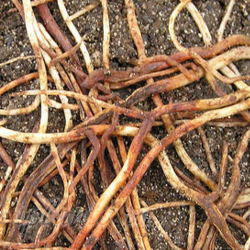
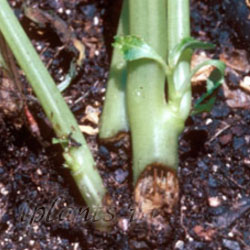

This is a group of diseases caused by a number of pathogenic fungi of the genera: Pythium, Rhizoctonia, Phytophthora etc. All these diseases sooner or later appear on the crown and tops of plants, but infection begins through root system. If the pathogen is serious and the plant is young (cuttings, seedlings, seedlings), then the leaves do not even have time to begin to turn yellow - the roots and lower part of the stem quickly rot.
Orchids, Saintpaulias, cacti and succulents are most susceptible to root rot. The reason is a violation of agricultural technology.
Black leg is the scourge of seedlings, manifested in the rotting of the lower part of the shoot or cuttings. Rot is the most typical - blackening, softening of tissues. Most of the blackleg affects when the soil is waterlogged, poor aeration, if the lumps of earth are so dense that there is a constant anaerobic environment around the roots. The source of infection is unsterilized soil mixtures, equipment, pots and planting boxes after diseased plants.
Late blight
This is a type of root rot. In this case, the plant first slows down its growth, fades somewhat, the leaves lose color, become pale, only then the roots rot and the plant dies. The first impression with this disease is that the plant does not have enough water, but after watering the turgor is not restored, and the leaves wither even more. In plants with dense leaves, the leaves do not fade, but become covered with extensive brown spots that start from the central vein.
Prevention
Choose the right soil for your plants, add more porous, draining materials to structure the soil. Do not use fine river sand or sand from a children's sandbox (quarry sand) - it cements the earthen mixture! Use small pebbles with a particle size of 3-4 mm, these can be bought in specialized departments and aquarium stores, or sift river pebbles. When planting, add the drug to the pot with the plant.
Make sure that the soil does not become waterlogged, water after the permissible degree of drying: if it is indicated that watering is abundant, it means that the soil in the pot should have time to dry out approximately 1/2 or 1/3 of the top part of the pot before the next watering. If you stick your finger into the soil, you will find that the soil on top is dry, but the inside of the pot is slightly wetter (cooler) - then you can water it.
If moderate watering is recommended for the plant, then the soil should dry out completely - if you immerse your finger in the pot, it should also be dry inside (the finger does not feel that it is cooler or wetter there). Of course, you don't have to stick your fingers into the soil before every watering. Just wait for the soil to dry out on top and wait another 2-3 days before watering so that it has time to dry out in the depths as well. And if it suddenly gets colder and the temperature drops, you may need to wait even longer - 5-7 days before the next watering.
To propagate indoor plants, cut off only healthy cuttings and leaves. Be sure to sterilize the soil for planting cuttings, especially if you are growing plants that are very susceptible to late blight and root rot (for example, gesneriaceae, gardenias, schefflera). Old, already used pots in which the plants have died must be scalded with boiling water.
Before planting, soak the seeds in a disinfectant, use, for example, the drug Maxim.
Control measures
With a large development of root rot, when a significant part of the roots has died, and most of the shoots have drooped and lost their elasticity, treatment is useless. If the tip of a petiole or twig turns black during rooting, you can cut it off, drop phytosporin into the water and put it back to rooting.
If the plant shows signs of wilting, and the soil is damp, you must immediately remove the plant from the pot. Rinse the root system, remove rot. If there are still healthy roots, treat them (soak for a few minutes) in a fungicide solution:
- Alirin B - 2 tablets per 10 liters of water
- gamair - 2 tablets per 1 liter of water
- ordan 5 g per 1 liter of water
- 3 ml per 2 liters of water
- bactofit 10 ml per 5 liters of water
- oxychome 10 g per 5 liters of water
- home 20 g per 5 liters of water
- Vitaros 2 ml per 1 liter of water
Spotting
This is a whole group of diseases that are both fungal and bacterial in nature.
Pathogens - fungi of the genera Ascochyta, Colletotrichum, Phyllosticta, Pestalotia, Septoria, Vermicularia etc. Spots are diseases whose causative agent is difficult to identify; it can be anthracnose, septoria, phyllostictosis, ascochyta, but the specificity of the spots is not expressed. In this case, brown spots appear on the leaves of the plant, which grow in size as the disease spreads, merge and affect the entire leaf. If the plant is strong enough, resistant to disease, or very well cared for, the spots grow slowly and the leaves dry out just as slowly.
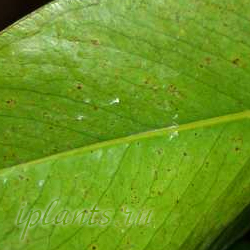

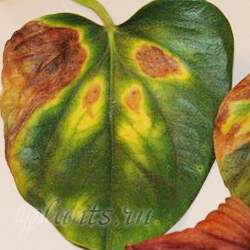
Spot prevention
Violations of living conditions contribute to the development of diseases. This waterlogging is especially aggravated by hypothermia of the root system (after watering with cold water or during transportation from the store to home during the cold season). Spots can also develop in warm, humid conditions, especially if there is poor air circulation and planting in dense clay soil.
Avoid crowding plants and overwatering. Regularly ventilate the room, greenhouses and provide good lighting. For prevention, water the plants with a solution of the drug or Bactofit. You can add tablets of the drug to pots when planting.
Control measures
In garden conditions, you need to collect and destroy any plant debris with stains from dead plants. Trim affected leaves and branches of house flowers. Spray with fungicides that can cope with most fungal infections.
- abiga peak 50 g per 10 liters of water
- acrobat MC 20 g per 5 liters of water
- oxychome 20 g per 10 liters of water
- home 40 g per 10 liters of water
- Alirin-B 2 tablets per 1 liter of water
- Vectra 3 ml per 10 liters of water
- 1% solution of Bordeaux mixture (100 g copper sulfate + 100 g lime per 10 liters of water)
- copper sulfate: 100 g per 10 liters of water
- Vitaros 2 ml per 1 liter of water
At home, you should try to treat indoor flowers for spotting with more affordable and simpler means: use the drugs Pistotsvet, Skor, Rayok - they are all available in small packaging, contain the same active ingredient - difenoconazole, dilute 2 ml per 5 liters of water. Spray the leaves with the solution, repeat after 2 weeks. Add zircon to the solution of these fungicides Chistotsvet, Skor, Rayok (6 drops per 1 liter of solution).
Red burn


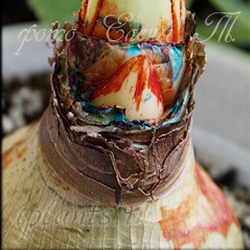
The causative agent is a fungus of the genus Stangospora Staganospora. A disease characteristic of hippeastrums and some bulbous plants.
Symptoms: red narrow spots appear on the leaves and peduncles, on which spore-bearing crusts subsequently form; the scales of the bulbs turn completely red. A diseased plant begins to deform the leaves and flowers, flowering does not begin or stops, and the bulbs rot.
Treatment
Treatment of bulbs with fungicides. You can use the drug Maxim (soaking the bulbs), but it can cause burns to the primordia of the leaves and peduncle - their tips have a very thin epidermis. The third photo shows burns from the drug Maxim, although the bulbs are cured, the burns will remain.
You can treat red burn of hippeastrum with other fungicides:
- foundationhol (benomyl) 1 g per 1 liter of water
- Vitaros 2 ml per 1 liter of water
- oxychome 4 g per 1 liter of water
Black spot

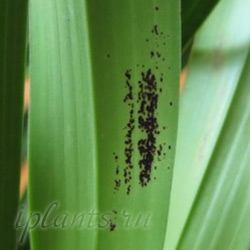
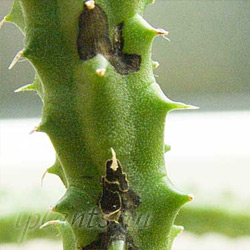
The causative agent is fungi of the genus Rhytisma, Dothidella.
Symptoms:
- Rhytisma acerinum - causes the formation of large round spots, initially yellowish and blurry. Then black dots appear on them, which gradually merge and form black shiny stroma (nodules), surrounded by a yellowish border. Sometimes there may be no yellowing around the black stromas.
- Rhytisma salicinum - causes similar lesions, only the spots are more convex, more angular in shape, large and small.
- Rhytisma punctatum - causes the appearance of small, dotted or teardrop-shaped, shiny black and convex stromas.
- Dothidella ulmi - causes the formation of grayish-black, rounded stroma; they are convex, shiny at first, later rough, like warts.
A combination of conditions contributes to the spread of the disease: high air humidity, shading and high temperatures.
Control measures
Spraying with fungicides:
- abiga peak 50 g per 10 liters of water
- acrobat MC 20 g per 5 liters of water
- benomyl (foundazole) 1 g per 1 liter of water
- Vectra 3 ml per 10 liters of water
- oxychome 20 g per 10 liters of water
- home 40 g per 10 liters of water
- Alirin-B 2 tablets per 1 liter of water
- Vitaros 2 ml per 1 liter of water
Spraying three times every 10 days.
Tracheomycosis
Tracheomycosis is a group of diseases called vascular wilts- pathogens enter through the roots and infect the vascular system of plants, clog the lumens of blood vessels with their mycelium, release toxins, the plant does not receive water and nutrients and begins to wither.
Tracheomycosis includes diseases such as:
- verticillium wilt (verticillium wilt)
- fusarium wilt (fusarium wilt)
- malsecco in citrus fruits
The symptoms are very similar, all diseases are diagnosed only in a laboratory, all are incurable, they are detected at the stage when pathogenic fungi have already poisoned the vascular system, this is something like blood poisoning in animals. Orchids, phalaenopsis, dendrobiums, cattleyas, etc. especially suffer from tracheomycosis. Other indoor flowers: fuchsias, roses, impatiens, begonias, geraniums; from garden: petunias, carnations, chrysanthemums, asters, dahlias. Vegetables that are prone to tracheomycosis are: cabbage, celery, cucumbers, tomatoes, peppers, eggplants, lettuce, melons, potatoes, pumpkin, radishes, rhubarb.
There are also plants resistant to tracheomycosis: Saintpaulia, ageratum, gypsophila, mallow, periwinkle, primrose, zinnia, asparagus, ferns, philodendrons. Of the vegetables, only corn and asparagus can resist.
In foreign practice, all tracheomycosis wilts are called simply: wilt - from wilt - to fade.
Verticillium wilt
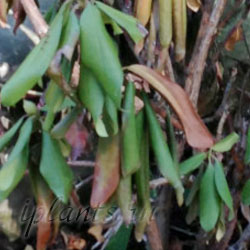
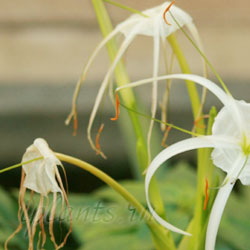
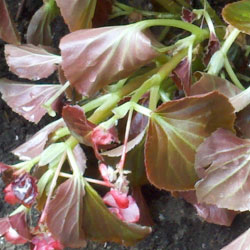
The causative agent is fungi of the genus Verticillium. It reproduces exclusively asexually - by conidia, affects plant roots and poisons xylem tissue: it grows and reproduces systemically throughout the plant.
Symptoms: at the initial stages of the disease, the lower leaves acquire a grayish-greenish color due to the development of interveinal necrosis. The leaf tissue between the veins turns brown and dries out. Then wilting begins, most of the leaves, starting from the bottom, turn yellow, curl and dry out. On a section of the stem, browning of the vessels is noticeable. The lumens of the vessels are filled with thin multicellular mycelium. Plants are stunted, develop poorly, and then die. Sometimes the disease manifests itself on the plant in the drying out and death of individual branches of the bush. If conditions are favorable, the disease spreads to other branches and the entire plant dies quite quickly. If conditions are unfavorable for the development of the fungus, the disease can drag on for months and part of the plant looks healthy, while part dies.
The pathogen persists in the soil in the form of microslerotia for several years. The optimal temperature for germination of sclerotia is 25-27°, humidity 60-70%. The fungus is most likely to develop on soil with a neutral pH value of 7-7.5. Fungal spores germinate and penetrate the conductive tissue, where mycelium develops, causing blockage of blood vessels. Since there is a gradual clogging of the vessels from bottom to top, the withering of the leaves begins with the lower leaves and gradually covers the entire plant.
Prevention
Do not use garden soil for indoor plants without pre-treatment: pour it onto a baking sheet in a 5 cm layer, heat it at maximum temperature for 20 minutes. Disinfect seeds by heating and disinfectants (for example, Maxim fungicide)
Control measures
Chemical agents, due to the unique biology of the pathogen (development in the soil and spread through conducting vessels), are ineffective. Treatment is only possible in initial stages, by spraying with foundationazole, Vectra (3 ml per 10 liters of water) or topsin-M at a concentration of 0.2%.
Fusarium (fusarium wilt)


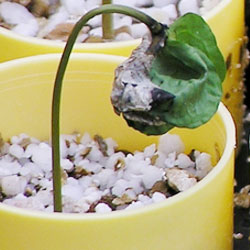
The causative agent is fungi of the genus Fusarium.
Fusarium develops only on weakened plants, primarily in dying areas. The course of the disease can follow the type of tracheomycosis wilt or with root rotting. Plants are affected at any age. The fungus is found in the soil and penetrates the plant through the soil and wounds, with water from natural sources, or with a non-sterile instrument during grafting or pruning. Increased air and soil humidity contributes to the spread of the disease.
Symptoms: In young plants, the disease manifests itself in the form of rotting of the roots and root collar. In these places, the tissues turn brown, the stem becomes thinner, and the leaves turn yellow. In affected plants, the tips of the shoots wither (loss of turgor), and then the entire shoot. This happens, as in the case of verticillium infection, due to blockage of blood vessels by toxins and enzymes secreted by fungi. Therefore, darkening of the vessels is also visible on the cross section. But sometimes tracheomycosis appears only on part of the crown, the rest remains healthy for the time being - then the bush or tree becomes depressed and individual branches droop. If you take cuttings from healthy branches at the right time (the cut is clean without darkening), you can root and get a healthy plant.
The speed of the disease depends on how favorable the conditions are for the development of the fungus. With high soil and air humidity, as well as temperatures above 18°C, the disease can destroy the entire plant in a few days. If the humidity is low, the disease can become chronic, in which case the plant slowly withers over 3-4 weeks.
Control measures
Removal and destruction of the plant along with a lump of earth. Disinfect pots with a 5% solution of copper sulfate, bleach, or at least scald with boiling water.
If wilting has just begun, you can try treating the plant with fungicides:
- Vectra 3 ml per 10 liters of water
- benomyl (foundazole) 1 g per 1 liter of water for orchids, 1 g per 100 ml
- Alirin B 2 tablets per 1 liter of water
- Vitaros 2 ml per 1 liter of water
Spraying three times, with an interval of 7-10 days.
How to treat orchids: get rid of the old substrate (throw it away, or boil the bark for at least half an hour). Cut off rotten roots. Prepare a fungicide solution and thoroughly spray the root system and leaves. Leave to dry. Plant in fresh substrate (large pieces of bark, polystyrene foam, cork). Do not spray, water by immersion as needed for a short time (5 minutes is enough). It is advisable to keep sick orchids at a temperature of 23-24°C, without drafts, in very intense but diffuse lighting (possibly under lamps).
The soil for large plantings (growing seedlings and transplanting tub plants) can be prepared by watering it properly with a solution of potassium permanganate (pink), the drug Maxim, or adding trichodermin. When working, sterilize tools - a knife, scissors and even garter material (wire, thread) with alcohol.
For many thousands of years, people have been decorating their homes. Comfort and beauty in the home help create harmonious relationships between all family members. One of the important techniques in this matter is growing indoor flowers. Various goals and objectives are solved by breeding beautifully flowering or simply ornamental plant varieties. I want to admire them not only summer period, but also throughout the year. In addition, houseplants are discreet helpers for resting the eyes and nervous system person. It’s not for nothing that they say that they are able to hear voices, capture people’s emotions and help their caring owner in time.
One of these evergreen gifts of nature, which has become popular recently, is the golden tree or aucuba.
Bright yellow spots located on large green leaves really look like gold bars. The first collections of these plants appeared in homes back in the 18th century. Until this time, only legends and stories from residents of areas with a humid subtropical climate were known about the plant. Especially the population of Japan could admire the beauty of this powerful shrub, which was later assigned to the genus of dogwood plants. For a long time, the Japanese did not allow it to be taken out of their country, attributing to it strong magical qualities. Travelers could only occasionally see aucuba in the gardens and parks of Japan.
The plant was brought to Europe only in the 17th century. And this was a female plant, without pollination of which it was impossible to begin to deal with issues of selection. Thanks to the English botanist Robert Fortune, a male aucuba seedling appeared a few decades later.
Due to difficulties with transportation, only wealthy families could buy, grow and breed aucuba. But every decade there were more and more people interested, and it was impossible to stop the active process of growing, studying the properties and spreading of various types of aucuba.
The genus includes only three species, two of which can grow in room conditions. These are the Japanese and Himalayan aucuba. In the wild, the plant can reach 4 m. Moreover, it takes well to pruning, which allows it to form a real tree with an interesting crown. Aucuba or “sausage tree” is one of the most shade-tolerant plants on the planet. Sometimes in the shade of impenetrable subtropical forests no other plants can be found except it.
Appearance of Aucuba
Aucuba is a shrub with large decorative leaves.
Aucuba very rarely blooms at home. But when this happens, small apical inflorescences of a red hue appear on it. Against the background of green, leathery, oval-shaped leaves with a serrated edge and golden spots across their entire surface, they look very beautiful. If female and male specimens grow side by side, then after flowering original oblong red fruits are formed, reminiscent of appearance berries of dogwood plants. They appear at the end of winter, beginning of spring.
The stem of the plant has woody properties. The leaves on it grow opposite. Their size can reach 20 cm in length and 7 cm in width. The height of aucuba at home can reach two meters.
Popular varieties of aucuba
Thanks to the work of specialists different countries Currently, various varieties of aucuba can be found on sale. Among them there are plants with green leaves and only in the center or along the edge there are small yellow spots. Some, on the contrary, sparkle with a golden sheen, drowning out the main green background of the leaves. Japanese and Himalayan aucuba are most often grown indoors:
- (Aucuba japonica). It grows naturally in the south of the Korean Peninsula and in Japan. There are varieties with green leaves and spotted forms. This species has a large number of forms with yellow spots different sizes and locations on leaves. The color of the berries can be not only red, but yellow and white. A beautiful bush-like form can only be created through regular spring pruning. It is recommended to use it as a separately growing tub bush.
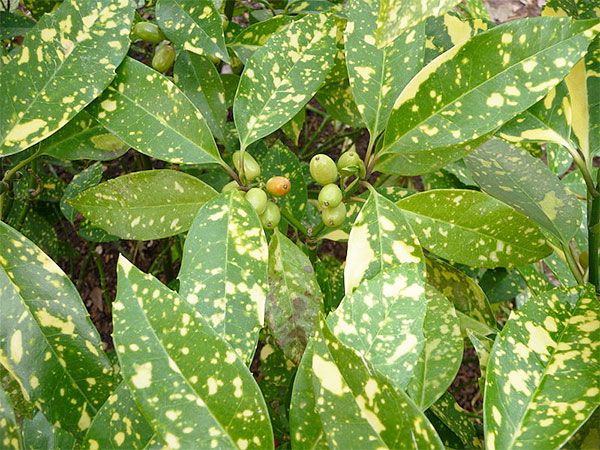 A. japonica
A. japonica - (Аucuba himalaica). The Eastern Himalayas are considered the homeland of the evergreen shrub. A dioecious plant with long pointed leaves that blooms in March and bears red fruits. Loves diffused sunlight and tolerates light shade well. It definitely requires regular pruning of fast-growing shoots.
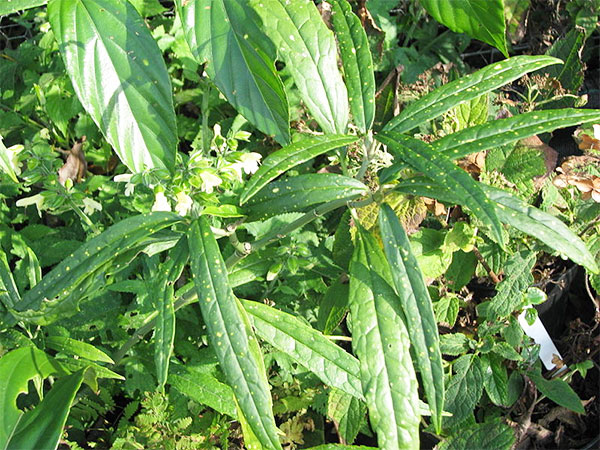 A. himalayan
A. himalayan Aucuba care at home
Aucuba is a simple, unpretentious indoor plant. But in order for it to sparkle with bright natural colors, you still need to follow certain rules for caring for it.
Aucuba planting
In the same pot, this plant can live and develop successfully for up to 10 years. This must be kept in mind when planting a seedling. A large pot must have good drainage and be sure to have a hole in the bottom of the bowl. The soil mixture must be composed of sand, turf soil and peat. The components are taken in equal quantities. An adult plant is transplanted by carefully transferring it into another container. A sign indicating the need for this procedure is filling the entire volume of the pot with a large number of roots.
Temperature and lighting
The flower loves moderate temperatures. If it stands in a sunny place, then the number of yellow spots on the leaves will be much greater. But the light should be diffused, not direct, although aucuba also grows well in partial shade. Prolonged exposure to too bright light leads to the loss of bright shades of foliage: they turn pale.
During the winter months, the optimal temperature for aucuba is between 8°C and 12°C. During the period when the local heating is on, you need to carefully monitor the plant. Dry air and high room temperatures can cause all the leaves to drop. To avoid this unpleasant phenomenon, it is necessary to monitor the temperature and spray the plant.
In summer, it is better to keep flower pots on the balcony, protecting them from drafts, bright sun and do not forget about watering.
The appearance of black spots on aucuba leaves may be due to improper wintering of the plant. This occurs when the aucuba is constantly exposed to high temperatures and low humidity. Temperature changes primarily affect the condition of the lower leaves, which turn yellow and fall off.
Watering and fertilizing
Watering a plant is one of the main agrotechnical measures for caring for it. It needs to be watered all year round at any time. In spring and summer, watering is plentiful, and moderate in the winter months. Each subsequent watering is done only on the dry top layer of soil in the pot. A sign of insufficient watering is even very small dried pieces of the edges of the leaves. In winter, black spots may also appear. Even in summer, the plant sheds its leaves when there is a lack of moisture.
Feeding the flower is combined with watering once a week, using a solution of complex mineral fertilizers. The composition, rules for using the fertilizer and its required quantity are indicated on the corresponding packaging. In winter, the plant is not fed. The appearance of small young leaves indicates a lack of nutrition and requires urgent additional feeding. Excess moisture also harms the plant and its leaves turn black.
Aucuba Reproduction
Aucuba propagates most often through apical cuttings of last year's shoots, cut at the end of winter and grown in a separate container to form roots. You need to save 3 leaves on the cutting by pinching its top. This is done to create conditions for branching of the future bush. The container with the cutting is covered with film or glass. The planted cuttings are periodically ventilated and moistened. After their rooting, the stage of picking them into a separate pot for growing follows. Young plants are transplanted to a permanent place after two years.
Despite the long-term possibility of growth in one place, it is recommended to transplant adult plants into another pot once every 5 years. This has a positive effect on increasing the number of golden spots on the leaves, which makes the plant more attractive.
Aucuba seed propagation is considered more difficult. Only the freshest seeds are used. They lose their germination very quickly, and you can simply waste time purchasing them from unknown manufacturers. The seeds are laid out on the surface of moistened peat, covered with film or glass and placed in a warm place. In this case, it is desirable to maintain a temperature of approximately 22°C. They need to be ventilated and moistened periodically. Seeds have a long germination period. If you still wait for the sprouts, then after the appearance of four leaves they need to be picked into separate pots for growing. The most unpleasant surprise during seed propagation is the lack of ability to transmit varietal qualities. Instead of golden leaves, the flower can only develop simple green shades.
Diseases and pests
The plant requires frequent careful inspection, as it is easily damaged by many pests. The most common of them are the mealybug. The fight against them is carried out through the use of special drugs.
Healing properties of aucuba
Aucuba is not just a beautiful and easy to grow plant. It contains active substances in its leaves that can destroy certain bacteria in the room that are harmful to the human body. Aucuba not only regulates air microflora, but can come to the aid of its owner at the right moment and provide first aid, for example, in case of injury or burn.
The leaves of the plant are applied to superficial wounds, tumors, local burns, frostbitten areas, and bruises. When using them, you must remember that all parts of the plant are poisonous and, when composing this or that recipe, you must strictly follow the recommended proportions of all components. So, for example, in case of frostbite or burn, you need to chop two leaves of the plant and apply this paste to the damaged area. Cover with a gauze bandage and change the entire compress every two hours.
The golden tree has amazing ability create an atmosphere of family unity and cohesion. It has a special effect on people with high self-esteem, which has turned into constant boasting. It’s hard to be around such a person for a long time without getting tired of the monotony of communication. It is the atmosphere of peace and tranquility created by the aucuba that helps the conversation with such a braggart to proceed in a friendly manner.
The energy of strangers coming to visit will not cause any unpleasant moments for the owner if this plant is in the room.
And it is not at all necessary to look for a clover flower with four petals, which brings wealth and happiness to the house. According to ancient beliefs and myths, it is enough to plant an aucuba in the house, care for it and with its help discover new opportunities, talents, and confidence in various matters. That is why a pot of aucuba given as a gift to a modest and shy friend is so highly valued, especially if he was born under the constellation Virgo.
